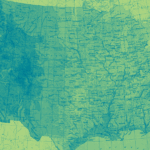“All great literature is one of two stories,” according to the quote usually attributed to Leo Tolstoy. “A man goes on a journey or a stranger comes to town.” Where the journey is concerned, perhaps no other text has had as much influence on writers or been borrowed from so frequently as Homer’s epic, The Odyssey. It’s true in my new crime novel, and many other books—from literary fiction to mysteries—by authors whom I admire.
For starters, of course, look no further than James Joyce’s Dublin-set Ulysses for a modernist example of a writer mining Odysseus’ ten-year journey to return home. But over the years, allusions to the Odyssey have populated numerous other novels, from William Faulkner’s As I Lay Dying to Charles Frazier’s Cold Mountain to Audrey Niffenegger’s The Time Traveler’s Wife, in which Claire likens herself to Penelope, continually “weaving and unweaving.”
On-screen, the Coen brothers based their 2000 film, “O Brother, Where Art Thou?” on the story of Odysseus’ journey home, with—in their version—escaped prisoner Ulysses Everett McGill (George Clooney) trying to win back his ex-wife, Penny (Holly Hunter.) On stage, playwright Melissa James Gibson visited the subject in “Current Nobody,” which finds photojournalist Penny covering the Trojan War while her husband, Od, a stay-at-home father, raises their daughter Tel (a gender swap for Odysseus’s son Telemachus.) Online, even the Star Trek universe got into the game with the 2007-2011 fan-created web series, “Star Trek: Odyssey,” which follows a crew struggling to travel 2.5 million light years home and includes such Odyssean episode titles as “The Wine Dark Sea” and “The Lotus Eaters.”
Similarly, in my new book, The End of the Road, I looked to the Odyssey for inspiration, drawing on my Kenyon College Classics major and an amateur’s appreciation of the epic form. In fact, my book coincidentally is being published almost forty years to the day after I submitted my senior college thesis, The Song, which fictionalized the story of a Homeric-era poet.
In my contemporary re-telling, protagonist Penny is the one on the journey, setting out to avenge the shooting in Columbus, Ohio, of her Odyssean boyfriend Myles. Her adversary is a cyclops-like one-eyed villain named Pryor who leaves Myles for dead after Myles, his former bank robbery driver, refuses to rejoin him for another job after being released from prison.
To complete her quest, Penny must leave behind her and Myles’s own Telemachus—“Mack” in the novel—and forge her way alone. But then, to her surprise, Penny receives some unexpected help from a rural Ohio sheriff’s deputy named J.P.—my Jupiter—who just happens to be married to a woman named June, a la Juno. A flashback features a Trojan Horse-style caper employed by Myles to avenge the theft of a car. And so on.
In taking this approach, I didn’t try to replicate the Odyssey comprehensively but rather signal my appreciation for Homer’s epic here and there. Whereas Penelope wove a shroud over several years for her father-in-law, for example, Penny knits a sweater in anticipation of Myles’s return from prison. In my version, Athena is an Amish-style restaurant server named “Tina” who aligns herself more with J.P. than Myles. But just as novelist Margaret Atwood gave Penelope the long overdue chance to narrate her story in the 2005 book, The Penelopiad, I too was drawn to the idea of telling the story from Penelope’s perspective, including what she might have accomplished if she wasn’t sitting at home fending off suitors while awaiting her man’s return.
Here are five other books that incorporate some elements of the Odyssey into modern stories.

The Lincoln Highway, by Amor Towles
The author pays homage to Homer with a character named Ulysses, a homeless, freight car-hopping World War II veteran on a destination-less odyssey around the country. Ulysses took this path after enlisting against the wishes of his wife, who punished him by disappearing with their son. Ulysses, a Black man who believes he was named for victorious Civil War General Ulysses S. Grant, appears doomed to a life of purposeless wandering until a bookish boy sets him straight on the real origins of his name. After reminding him that Homer’s hero journeyed for ten years, and learning that this Ulysses has been on the road for eight, the boy informs him, “you will be reunited with your family in less than two years’ time.”

This Tender Land, by William Kent Krueger
Author and mythology expert Joseph Campbell included Odysseus’ travels among several archetypal “hero journeys.” Krueger’s stand-alone novel is a masterful blend of such narratives, including Huckleberry Finn. But nods to the Odyssey abound. Rivers, including the Minnesota and Mississippi, take the place of the Aegean as Odysseus “Odie” O’Bannion and his companions paddle their way toward St. Louis and his aunt’s house on Ithaca Street. Other allusions include Odie and company’s encounter with Jack, a one-eyed farmer who imprisons them for a while in a shed a la the Odyssean cyclops. (In this telling, it’s Odie’s brother, Albert, who takes the name “Norman .. neither boy nor man,” a play on the name Odysseus uses—“No One”—to fool the cyclops.) Likewise, Odie struggles with the notion that he was cursed by an evil “Tornado God,” hearkening to Odysseus’s antagonistic relationship with Poseidon. That “vengeful spirit,” Odie laments, “had attached itself to me and had followed me everywhere.”

ODY-C, by Matt Fraction and Christian Ward
In this multivolume sci-fi graphic novel reimagining, Odysseus has become a woman warrior, Odyssia, whose crew of female soldiers including “Gamen” (a nod to Agamemnon) and “Ene” (for Menelaus) leave behind the ruins of “Troiia” to undertake a long voyage home. Odyssia only wants to return to “Ithicaa” and to her wife, Penelope (a Sebex being, imagined as a third gender). Yet angry gods including “Cosmic Poseidon” have other plans for Odyssia, who soon finds herself waylaid and wondering what the journey will entail. “Traveling home should at least fill my soul,” Odyssia muses. “Yet distraction and battle still lure me away.”

Summer of the Mariposas, by Guadelupe Garcia McCall
McCall’s young adult novel combines elements of the Odyssey with Mexican folklore to tell the story of a girl named Odilia, who with her four sisters embarks on a journey to return a man’s body to his family in Mexico. Along the way, they encounter a Circe-like sorcerer named La Bruja Cecilia and a Sirens-like coven of luchezas (roughly translated in this context as owl-witches). “I wanted to see if I could take one of the greatest stories ever told—a male-oriented story—and turn it upside down to make it all about the power of being female,” McCall said in an interview.

Didn’t Nobody Give a Shit What Happened to Carlotta, by James Hannaham
Possibly the most raucous, exuberant, and edgy Odyssey retelling in recent memory (if ever), Hannaham’s novel reimagines the epic Greek wanderer as Carlotta Mercedes, a Black Columbian trans woman recently released from prison in Ithaca, New York, after a twenty-year sentence. The novel unfolds in Joycean fashion over the 2015 Fourth of July weekend in New York City, with Carlotta seeming, as the Los Angeles Times noted, “like a trans female Odysseus returned from the Trojan Wars and trying to find her way home.” In a classic Odyssey nod, Carlotta tells her cyclops, a one-eyed man named “Paulie Famous” (harking back to the Polyphemus of the original), “Oh, I’m nobody.” In a nifty allusion to an allusion, the novel’s conclusion even echoes the famous end of Joyce’s Ulysses—“…yes I said yes I will Yes”—with Carlotta’s version of the same: “… said hell to the yes I’m saying YASSS.”
***


















